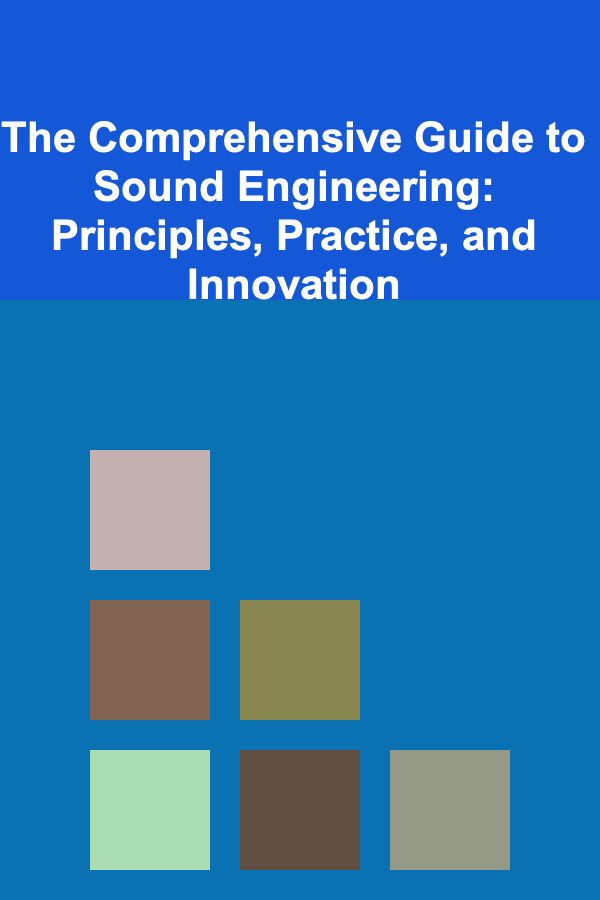
The Comprehensive Guide to Sound Engineering: Principles, Practice, and Innovation
ebook include PDF & Audio bundle (Micro Guide)
$12.99$11.99
Limited Time Offer! Order within the next:

Sound engineering is an essential field in both music production and various industries like film, television, gaming, and live events. It blends art with science, requiring both technical knowledge and creative skills. This guide explores the principles of sound engineering, the practical techniques used in the field, and the innovations shaping its future. Whether you're a beginner or a seasoned professional, this article will provide valuable insights into the world of sound engineering.
Principles of Sound Engineering
Sound engineering is built upon fundamental principles that govern the creation, manipulation, and reproduction of sound. Understanding these principles is crucial for any sound engineer.
1. The Nature of Sound
Sound is a mechanical wave that travels through a medium (air, water, or solid substances) via vibration. When an object vibrates, it displaces particles in the surrounding medium, creating waves of pressure variation. These pressure variations reach our ears, which detect them as sound.
There are several important concepts to understand when working with sound:
- Frequency: The number of vibrations per second, measured in Hertz (Hz). Frequency determines the pitch of a sound.
- Amplitude: The magnitude of pressure variation, which correlates to the volume or loudness of a sound. Amplitude is measured in decibels (dB).
- Waveform: The shape of the sound wave, which influences its timbre or tone quality. Complex sounds can be broken down into simpler sine waves.
- Wavelength: The distance between two consecutive points in a wave, such as from peak to peak. Wavelength is inversely related to frequency.
Understanding these concepts allows sound engineers to manipulate sound waves with precision, ensuring that they produce the desired effects in a recording or performance.
2. The Role of Sound Waves in Different Environments
Different environments influence the way sound behaves. The study of acoustics---how sound interacts with spaces---is vital for sound engineers. Key concepts include:
- Reflection: When sound waves bounce off surfaces. This can create echoes or reverberations, which must be controlled for clarity, especially in recording studios and concert halls.
- Absorption: Materials like foam, carpet, and curtains can absorb sound, reducing reflections and controlling the acoustics of a space.
- Diffusion: The scattering of sound waves in different directions. Well-designed rooms use diffusion to create balanced, even sound coverage.
- Reverberation: The persistence of sound in a space due to multiple reflections. While some reverberation is desired in certain environments, too much can lead to muddiness or a lack of clarity.
Sound engineers must design spaces and select equipment that maximize acoustic quality, ensuring the clearest possible sound without unwanted distortion or interference.
The Practical Side of Sound Engineering
Sound engineering involves a mix of technical skills and creative expertise. Below, we dive into the practical tools, techniques, and processes sound engineers use to shape the sound of a project.
1. Microphones and Recording
Microphones are the first step in capturing sound. Different types of microphones are designed to pick up sound in various ways, and choosing the right one is essential to capturing the desired audio.
- Dynamic Microphones: Known for their durability and resistance to high sound pressure levels, these mics are commonly used in live sound environments.
- Condenser Microphones: These microphones are highly sensitive and are ideal for studio recordings, especially for vocals and acoustic instruments.
- Ribbon Microphones: These capture sound with a unique, vintage sound quality, often used in orchestral or studio recording settings.
In recording, sound engineers must consider the placement of microphones. The distance, angle, and proximity to sound sources all impact the quality of the recording. Techniques like the 3-to-1 Rule (placing microphones three times further apart than their distance from the sound source) help reduce phase cancellation.
2. Signal Processing
Once the sound is captured, it often needs to be processed to achieve the desired sonic characteristics. This is done using various tools in the studio:
- Equalization (EQ): EQ adjusts the balance of different frequency ranges in a sound. A common use of EQ is to enhance the bass or treble of a sound or reduce unwanted frequencies (e.g., low hums or harsh high frequencies).
- Compression: Compression reduces the dynamic range of an audio signal, making loud sounds quieter and quiet sounds louder. This is particularly useful in vocals and drums, where consistent volume is crucial.
- Reverb and Delay: These effects are used to create space and depth in a sound. Reverb mimics the reflections that occur in physical spaces, while delay involves repeating the sound after a brief interval, often used creatively in music production.
- Distortion and Saturation: These effects intentionally add harmonic content to a sound, making it "grittier" or more aggressive. They are common in rock music and electronic genres.
These processes allow sound engineers to refine the raw recordings and shape the audio to meet the artistic vision of the project.
3. Mixing
Mixing is where all the individual elements of a recording come together. A sound engineer's role in mixing involves balancing the levels, applying effects, and ensuring that each track sits perfectly in the overall soundscape.
Key elements of mixing include:
- Level Balance: Ensuring that each instrument or sound in a track is audible and contributes to the overall balance. Instruments should complement each other without one overpowering another.
- Panning: Panning positions sounds in the stereo field, from left to right. This gives the listener the perception of space and movement.
- Automation: The process of dynamically adjusting volume levels or effects during the track. Automation allows for intricate changes throughout a song or sound piece, adding expressiveness.
- Harmonic Balance: Adjusting EQ to ensure the track sounds balanced and cohesive. This may involve cutting frequencies that clash or enhancing frequencies that are lacking.
The goal of mixing is to create a harmonious and engaging sound that evokes the intended emotional response from the listener.
4. Mastering
Mastering is the final step in the audio production process, where the mixed track is polished and optimized for distribution. A mastering engineer prepares the track for various formats, ensuring it sounds its best across all devices, from headphones to large speakers.
Mastering involves several key processes:
- Final EQ adjustments: Fine-tuning the overall tonal balance of the track.
- Compression and Limiting: Applying compression to ensure the track maintains consistency, and limiting to prevent distortion caused by excessive loudness.
- Stereo Imaging: Adjusting the stereo width of the track for optimal spatial distribution.
- Noise Reduction: Removing any unwanted background noise or artifacts that may have been introduced during the recording or mixing process.
The final master is the blueprint for the sound in all future formats, ensuring that the artist's vision is accurately represented no matter where it's heard.
Innovation in Sound Engineering
Sound engineering is a constantly evolving field, with new technologies and techniques being developed to push the boundaries of what's possible. Here are some of the most exciting innovations currently shaping the field.
1. Digital Audio Workstations (DAWs)
Digital Audio Workstations (DAWs) have revolutionized the way sound is recorded, edited, and mixed. Software like Pro Tools, Logic Pro, Ableton Live, and FL Studio offer powerful tools for multi-track recording, sound manipulation, and effect processing. The flexibility of DAWs allows for more complex arrangements and the ability to integrate new technologies like:
- Virtual Instruments: Software that mimics real instruments or creates entirely new sounds.
- Audio Plugins: Tools that add effects or instruments, from EQ to reverb to simulation of analog equipment.
- MIDI: Allows for the creation of music with virtual instruments and sequencing, without needing live performers.
DAWs have democratized music production, making it accessible to more people while maintaining professional-grade quality.
2. Immersive Audio and 3D Sound
With the rise of virtual reality (VR) and augmented reality (AR), sound engineering is moving toward immersive, three-dimensional sound experiences. Technologies like binaural audio and object-based audio (used in Dolby Atmos and DTS:X) allow sound to be placed dynamically in 3D space, creating an unprecedented level of immersion.
In these formats, sound moves around the listener in real-time, adding layers of depth to video games, movies, and interactive media.
3. AI and Machine Learning in Sound Design
Artificial intelligence (AI) and machine learning are increasingly being integrated into sound engineering tools. AI can help automate time-consuming processes, such as noise reduction, mixing, and mastering, and even create music. For example, AI algorithms can identify key features in a recording and automatically apply EQ or compression settings that would traditionally require manual adjustments.
Machine learning is also being used to create new sound effects and enhance the process of sound synthesis, allowing sound designers to create innovative and unique auditory experiences.
Conclusion
Sound engineering is a dynamic and fascinating field that combines technical knowledge, creative artistry, and the latest technological advancements. Whether you're working in a recording studio, designing sound for film or video games, or creating immersive audio experiences for VR, understanding the principles of sound, mastering the techniques of recording and mixing, and embracing innovations are key to becoming a skilled sound engineer.
As the industry continues to evolve, sound engineers will remain at the forefront, shaping how we hear and experience sound in the digital age. With a solid foundation in the principles of sound engineering and an eye toward future innovations, the possibilities for creative expression and technological advancement are limitless.

Best Practices for Writing Compelling Copy for One-Page Websites
Read More
How to Maintain Your Rental Property on a Budget
Read More
How To Master Cross-Selling and Upselling in Your POD Store
Read More
How to Use Financial Apps to Track Your Progress and Goals
Read More
Cultivating a Sense of Belonging: Weaving Connection in a Fragmented World
Read More
How to Integrate Email Marketing with CRM Systems
Read MoreOther Products

Best Practices for Writing Compelling Copy for One-Page Websites
Read More
How to Maintain Your Rental Property on a Budget
Read More
How To Master Cross-Selling and Upselling in Your POD Store
Read More
How to Use Financial Apps to Track Your Progress and Goals
Read More
Cultivating a Sense of Belonging: Weaving Connection in a Fragmented World
Read More